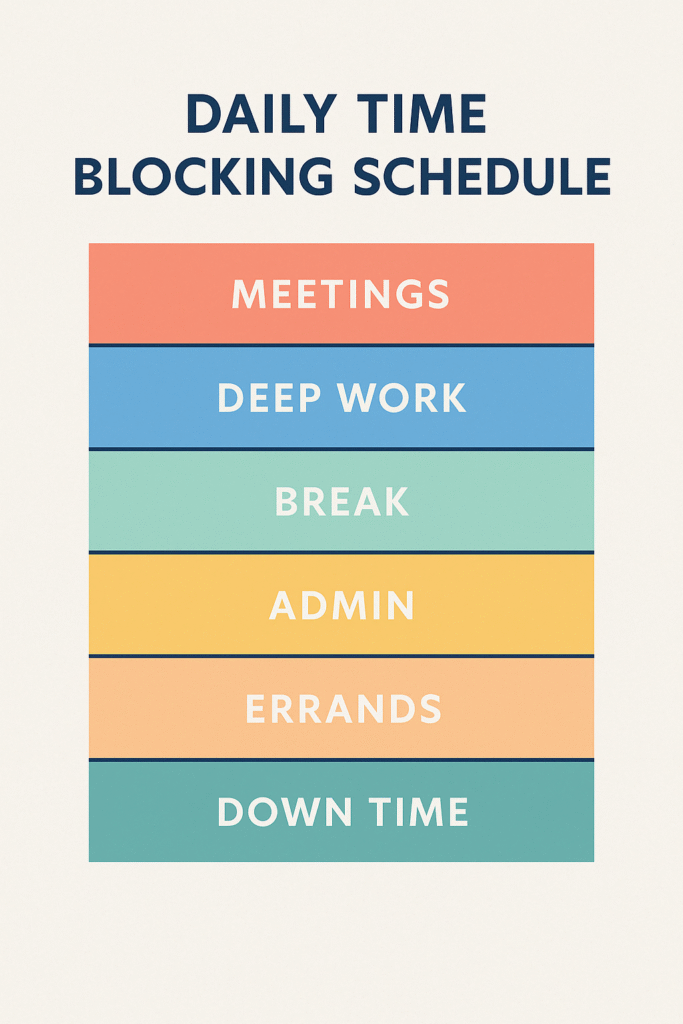Have you ever ended the day feeling like you were constantly busy but accomplished almost nothing that mattered? That used to be me—until I discovered the daily time blocking method.
Unlike traditional to-do lists, time blocking forces you to think about when you’ll do something, not just what needs to get done. This small shift changed everything: I started focusing better, finishing tasks faster, and feeling more in control of my day.
In this article, I’ll walk you through how daily time blocking works, why it’s so effective, and exactly how to implement it in your own routine—even if your days are unpredictable.
2. What Is Time Blocking and Why Does It Work?
Time blocking is a productivity technique where you divide your day into chunks of time—each dedicated to a specific task, category, or type of work. Instead of relying on a long to-do list, you assign when you’ll do something, giving structure to your entire day.
This method works because it combats one of the biggest killers of productivity: decision fatigue. When your day is mapped out, you don’t waste time figuring out what to do next or bouncing between tasks. You enter each time block with clarity, which increases focus and reduces distractions.
Unlike multitasking, which splits your attention, time blocking encourages deep, focused work. It also helps you become more aware of how long things actually take, making future planning more accurate and realistic.
Whether you’re managing work meetings, study sessions, or personal projects, time blocking transforms how you approach your time—it shifts your mindset from reactive to proactive.
3. How I Started Using Time Blocking
When I first heard about time blocking, I was skeptical. It sounded rigid, maybe even stressful—how could mapping out every hour possibly make me feel less overwhelmed? But after a week of trying it out, I was hooked.
At the beginning, I made a few classic mistakes: I blocked too many hours without breaks, underestimated how long tasks would take, and didn’t account for unexpected distractions. My calendar looked perfect—on paper—but real life wasn’t following the script.
So I made adjustments. I started small: just blocking time for my top three priorities each day. I added 15-minute buffer zones between tasks. I left open space in the afternoons for anything that ran over or came up last minute. And instead of planning the whole week in detail, I built a rough weekly skeleton and filled in each day the night before.
What helped most was using tools I already liked. I started with Google Calendar for digital scheduling, then experimented with a bullet journal for visual planning. Both had their pros, but the real shift happened when I treated time blocking as a flexible framework, not a rigid schedule.

4. How to Create Your Own Daily Time Block Schedule
Ready to give time blocking a real shot? Here’s how to create a schedule that works with your life—not against it.
Step 1: List out your recurring tasks and top priorities.
Start with what you already know you’ll need to do—meetings, commute, meals, workouts, deep work sessions, etc. Then, list your weekly or daily goals. This gives you the raw material for your time blocks.
Step 2: Categorize your time.
Group your tasks into types of activity: deep work, admin, meetings, errands, breaks. This makes scheduling easier and helps balance your energy levels throughout the day.
Step 3: Choose your tool.
You can use a digital calendar (like Google Calendar), a planner app (like Notion or Sunsama), or a paper planner. Choose what you’ll actually stick with.
Step 4: Block your time.
Assign tasks to specific blocks in your day. Start with fixed commitments, then place your priorities around them. Don’t forget to include buffer time, breaks, and even downtime. Overplanning leads to burnout—leave room to breathe.
Once your schedule is set, try it out for a day or two and see how it feels. You’ll likely need to make small tweaks—but that’s all part of the process.
5. Adjusting and Improving the System Over Time
Time blocking isn’t about perfection—it’s about progress. One of the biggest mistakes people make is expecting their schedule to work flawlessly from day one. But your time blocking system should evolve with you.
As you begin using it daily, you’ll start to notice patterns: tasks that consistently take longer than expected, blocks that get interrupted often, or times of day when you’re less focused. These observations are gold. Use them to refine your blocks.
Build in moments to evaluate your schedule. At the end of each day, take a quick look: What worked? What didn’t? On a weekly basis, spend 10 minutes reflecting on trends. Did you overcommit? Did you allow time for rest? Are your priorities reflected in your calendar?
You can also layer time blocking with other techniques—like the Pomodoro Technique for focused work within blocks, or task batching to group similar tasks and reduce context-switching. Don’t be afraid to experiment until you find your rhythm.
Time blocking isn’t a rigid cage—it’s a flexible framework. The more you adapt it to your lifestyle, the more powerful and personalized it becomes.

Time blocking isn’t just a trendy productivity hack—it’s a mindset shift. Instead of reacting to your day, you design it. You decide what gets your time, your energy, and your attention. And over time, those choices create real, lasting impact.
You don’t need to plan every hour perfectly or use complex tools. Start with just one day. Choose a few tasks, block out your time, and see how it feels. From there, adjust, refine, and build a system that works with your flow.
Whether you’re juggling meetings, managing a side hustle, or just trying to stay focused, time blocking can help you stay grounded—and get things done.
Looking for more productivity tips? Explore our latest articles.

Daniel Carter believes that small daily changes lead to extraordinary results. Through simple and effective strategies, he inspires readers to take control of their routines, overcome procrastination, and unlock their full potential.











